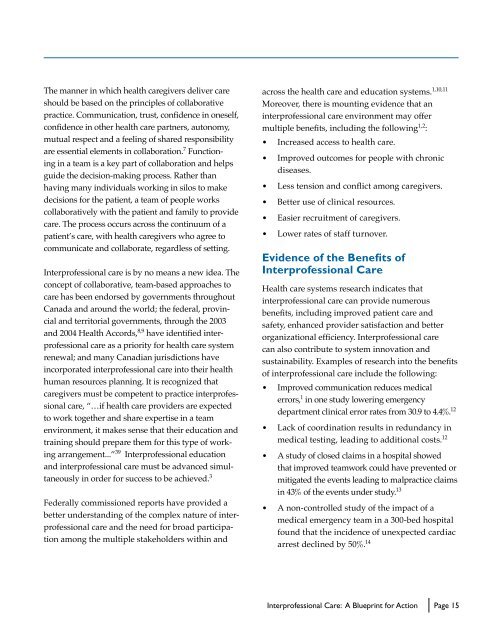Interprofessional Care: A Blueprint for Action - HealthForceOntario
Interprofessional Care: A Blueprint for Action - HealthForceOntario
Interprofessional Care: A Blueprint for Action - HealthForceOntario
Create successful ePaper yourself
Turn your PDF publications into a flip-book with our unique Google optimized e-Paper software.
The manner in which health caregivers deliver care<br />
should be based on the principles of collaborative<br />
practice. Communication, trust, confidence in oneself,<br />
confidence in other health care partners, autonomy,<br />
mutual respect and a feeling of shared responsibility<br />
are essential elements in collaboration. 7 Functioning<br />
in a team is a key part of collaboration and helps<br />
guide the decision-making process. Rather than<br />
having many individuals working in silos to make<br />
decisions <strong>for</strong> the patient, a team of people works<br />
collaboratively with the patient and family to provide<br />
care. The process occurs across the continuum of a<br />
patient’s care, with health caregivers who agree to<br />
communicate and collaborate, regardless of setting.<br />
<strong>Interprofessional</strong> care is by no means a new idea. The<br />
concept of collaborative, team-based approaches to<br />
care has been endorsed by governments throughout<br />
Canada and around the world; the federal, provincial<br />
and territorial governments, through the 2003<br />
and 2004 Health Accords, 8,9 have identified interprofessional<br />
care as a priority <strong>for</strong> health care system<br />
renewal; and many Canadian jurisdictions have<br />
incorporated interprofessional care into their health<br />
human resources planning. It is recognized that<br />
caregivers must be competent to practice interprofessional<br />
care, “…if health care providers are expected<br />
to work together and share expertise in a team<br />
environment, it makes sense that their education and<br />
training should prepare them <strong>for</strong> this type of working<br />
arrangement...” 39 <strong>Interprofessional</strong> education<br />
and interprofessional care must be advanced simultaneously<br />
in order <strong>for</strong> success to be achieved. 3<br />
Federally commissioned reports have provided a<br />
better understanding of the complex nature of interprofessional<br />
care and the need <strong>for</strong> broad participation<br />
among the multiple stakeholders within and<br />
across the health care and education systems. 1,10,11<br />
Moreover, there is mounting evidence that an<br />
interprofessional care environment may offer<br />
multiple benefits, including the following1,2 :<br />
• Increased access to health care.<br />
•<br />
•<br />
•<br />
•<br />
•<br />
Improved outcomes <strong>for</strong> people with chronic<br />
diseases.<br />
Less tension and conflict among caregivers.<br />
Better use of clinical resources.<br />
Easier recruitment of caregivers.<br />
Lower rates of staff turnover.<br />
Evidence of the Benefits of<br />
<strong>Interprofessional</strong> <strong>Care</strong><br />
Health care systems research indicates that<br />
interprofessional care can provide numerous<br />
benefits, including improved patient care and<br />
safety, enhanced provider satisfaction and better<br />
organizational efficiency. <strong>Interprofessional</strong> care<br />
can also contribute to system innovation and<br />
sustainability. Examples of research into the benefits<br />
of interprofessional care include the following:<br />
• Improved communication reduces medical<br />
errors, 1 in one study lowering emergency<br />
department clinical error rates from 30.9 to 4.4%. 12<br />
•<br />
•<br />
•<br />
Lack of coordination results in redundancy in<br />
medical testing, leading to additional costs. 12<br />
A study of closed claims in a hospital showed<br />
that improved teamwork could have prevented or<br />
mitigated the events leading to malpractice claims<br />
in 43% of the events under study. 13<br />
A non-controlled study of the impact of a<br />
medical emergency team in a 300-bed hospital<br />
found that the incidence of unexpected cardiac<br />
arrest declined by 50%. 14<br />
<strong>Interprofessional</strong> <strong>Care</strong>: A <strong>Blueprint</strong> <strong>for</strong> <strong>Action</strong> Page 15





